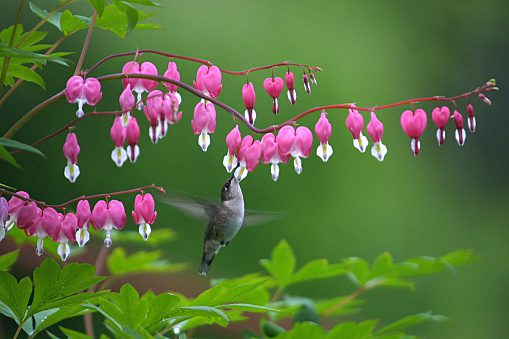
Last updated on May 20th, 2023 at 06:13 pm
The bleeding heart flower (scientific name: Lamprocapnos) is native to Europe and South and Central America. This flower has a name in the United Kingdom and has had a few other words throughout its history. This flower’s name comes from its look, which depicts a heart at the top.
This flower has a lot of good qualities, and some people believe its root has medicinal capabilities. However, it isn’t used in modern medicine, and this flower is now used mainly for decoration and space beautification.
The bleeding hearts flower has a very descriptive common name, and it’s easy to see why when you see it. It appears to be bleeding! Aside from that, the bleeding heart flower’s scientific name explains it. Dicentra spectabilis is its scientific name. Dicentra refers to the flower’s two spurs, which are highly noticeable.
On the other hand, Spectabilis means “spectacular.” This flower’s name could not be more fitting—it is truly breathtaking to behold! The bleeding heart is bold and dramatic, unlike some delicate flowers that send contradictory messages.
This flower has numerous names, yet the plant has the same essential meanings no matter how it is offered.
What does the Bleeding Heart flower symbolize?

The bleeding heart flower, meaning in eastern culture, is rejected or denied love. However, as we already know, even if love happens on one side, it is proper for oneself. And in case the other person does not want to be in a relationship, that is fine.
The bleeding heart flower symbolizes living life to the fullest or dying for it. This plant can be found in the Asian region, one of those blossoms that have survived for many years and offer a narrative about the failure to accept love.
Though we analyze the concept of a bleeding heart, it refers to someone soft on the inside. This showcases that the person’s character is serene, tranquil, and transparent. These red bleeding hearts flowers are commonly associated with poor luck, difficulty, and disappointment.
All in all, the bleeding heart flower symbolic meanings are:
- passionate love
- romance
- unrequited love
- broken heart
- compassion
Meaning of the Bleeding Heart flower colors
White color
White is a symbol of compassion and innocence. The color is associated with the human spirit’s love and purity. White bleeding hearts perfectly showcase that the human soul is so pure and innocent that it must be protected. Her purifier is so powerful and bright that she can defeat even the most potent darkness.
As a result, this shade reminds us to believe in one, combat bad ideas and deeds, and feel love.
Blue color
The color blue mirrors our feelings; it is the same hue as the sea, the ocean, and the sky. Therefore its power is immense. The color blue denotes that our potential is boundless. It also tells us that we must believe in our abilities, be free, and not allow anyone to limit us.
Freedom, strength, calm, and relaxation are all associated with blue. When we see this color, it is lovely to discover many blue flowers. Blue is a gorgeous color since it emits positive energy.
Pink/Red color
Pink is associated with love, companionship, and home warmth, and it aids us in expressing our thoughts, trusting in ourselves, and achieving our goals. This color indicates the hot feelings we desire to say yet keep hidden deep within us.
Interesting facts about the Bleeding Heart flower
- The underground rhizome of the bleeding heart stores the nutrients and energy essential for growing leaves and blooms in the early spring.
- During the spring and summer, a bleeding heart blooms. Flowers have a lot of nectar, which draws hummingbirds, the plant’s significant pollinators.
- Bleeding-heart flowers are native to oriental lands. They are found in southern Siberia, northeastern China, Japan, and Korea. Bleeding-heart flower meanings may vary based on culture, but they signify heart affairs across the world.
- Bleeding hearts are woodland flowers. In cold regions, they can handle the full sun. In warmer climates, they grow in partial shade conditions.
- It is a great source of nectar and attracts hummingbirds and other pollinators.
- Every part of the plant is poisonous. It causes skin irritation in people. If cows eat the vine or the bush, they can die from it.
- This plant is a food source for some butterflies, aphids, and snails.
- Native Americans use the bleeding heart to treat stomach pain, cough, insect bites, and dizziness.
- It is also used to treat hair loss.
- Some varieties of bleeding hearts have golden yellow leaves which resemble ferns.
- Since it is a perennial, it can live for more than 2 years in the wild.
How to grow Bleeding Heart flowers
The bleeding-heart plant is a perennial that grows to 3 feet in height. It grows best in the shade and has powdery green leaves. Some varieties of the bleeding heart have foliage that resembles ferns. The leaves grow in the shape of a rosette. Every stem has up to 20 flowers which hang like pendants. The flowers can be 1 or 2 inches long and dangle on arching stems. Each flower has two heart-shaped petals which puff out. The shape looks like a tiny lantern. Small white inner petals appear to drip from within. The flowers have a delicate perfume.
- Bleeding heart plants like moist and humus-rich soil.
- The soil should have a lot of organic matter and be slightly acidic. Add a 2-to-3-inch layer of compost or manure to the soil regularly.
- Aerating regularly will help the root system to grow and thrive. Soil that drains well will prevent root rot.
- Bleeding hearts should be well watered and more so in the summer. The plants require at least an inch of water a week.
How to care for Bleeding Heart flowers
- Allow plenty of air circulation and ventilation for the bleeding heart flower plant.
- Check the soil every day to ensure that it feels damp.
- When the soil begins to dry out, water the plant.
- During the spring and summer, mist an indoor bleeding heart every day.
- Fertilize the plant every two weeks with half the recommended amount of fertilizer.
- Adjust the watering or sun exposure if the leaves turn yellow before summer.
- If you spot insects on the plant, spray it with insecticidal soap.
Best time to gift Bleeding Heart flowers
A bleeding heart flower is a suitable gift for many circumstances.
If you have a special occasion and want to host a romantic dinner or celebrate an anniversary, bleeding heart flowers are the best choice.
A wedding is also one of the ideal occasions to give the bleeding heart flower. These flowers are commonly used in bouquets and as table decorations.
Bleeding heart flowers are the perfect gift for a friend or loved one on Valentine’s Day.
It is also appropriate when offered to remember a loved one who has passed away.
Bleeding heart flowers are used in flower arrangements and other bouquets. You can give a bleeding heart flower plant in a pot to a couple just starting a life together and wish them a great life together.
Since you now know the bleeding heart flower meaning by color, you can decide which one to give as a gift. Any color of this unusual flower is the perfect choice to express love and togetherness.
Conclusion
Thanks to their unusual shape and color combinations, the bleeding-heart flower is a fitting symbol for romance, passion, and romantic love.
In the language of flowers, it expresses love and romance elegantly. The flower’s heart shape, petals, and stamen look like “drops of blood” waiting to fall from the bloom. No wonder it stands for unrequited love or a broken heart in many cultures.
Bleeding heart flowers are good gifts for romantic occasions and add interest to a bouquet. They also add interest to a landscape and brighten shady spots in a garden.
If you want to know and learn more about flowers, we at PansyMaiden can help you. Check out our fun, easy-to-read, and informative flower-related content that you will surely enjoy!

